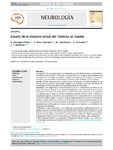Estudio de la situación actual del Teleictus en España

Ver/
Use este enlace para citar
http://hdl.handle.net/2183/37139
A non ser que se indique outra cousa, a licenza do ítem descríbese como Creative Commons Attribution-NonCommercial-NoDerivs 4.0 International License (CC-BY-NC-ND 4.0)
Coleccións
- Investigación (FCS) [1293]
Metadatos
Mostrar o rexistro completo do ítemTítulo
Estudio de la situación actual del Teleictus en EspañaTítulo(s) alternativo(s)
The current situation of Telestroke in SpainAutor(es)
Data
2023-08-07Cita bibliográfica
Barragán-Prieto A, Pérez-Sánchez S, Castellanos M, González A, Montaner J. Estudio de la situación actual del Teleictus en España. Neurología. 2023 Aug 7. Epub ahead of print.
Resumo
[Resumen] Introducción. En los últimos años se ha establecido el uso del Teleictus como una herramienta fundamental para extender la atención a los pacientes con ictus agudo hasta hospitales que no disponen de neurólogos de guardia. El objetivo principal de este trabajo es describir la existencia y funcionamiento de los distintos sistemas y redes de Teleictus (ST) en España.
Método. Estudio transversal de la situación actual del Teleictus en España mediante la realización de una encuesta estructurada dirigida a los miembros del Grupo de Estudio de Enfermedades Cerebrovasculares de la Sociedad Española de Neurología.
Resultados. Han respondido a la encuesta desde 12 de las 17 comunidades autónomas, de las cuales 10 tenían ST. Además, en la búsqueda bibliográfica se han encontrado otros 2 sistemas funcionando. Doce de las 17 comunidades autónomas de España disponen de ST, consiguiendo una cobertura de al menos el 20% de la población española. De estos 10 ST, 7 tienen una organización regional, 2 provincial y otro, hospitalaria. En la mayoría de los ST (9) se realizan al menos TC simple y angio-TC, y en 4 ST también imagen de perfusión. Nueve ST funcionan con equipos de videoconferencia profesionales. Sin embargo, la calidad subóptima de la exploración por videoconferencia es el principal problema identificado en el 50% de los ST. Otros problemas detectados son la dificultad en la obtención de datos de los registros y la transferencia de imágenes entre hospitales.
Conclusión. En los últimos años, se ha observado una expansión significativa de los ST en España, lo que ha permitido mejorar la accesibilidad de la atención especializada en casos de síntomas de ictus agudo. Este estudio permite describir los diferentes tipos de ST en España, detectar áreas de mejora y crecimiento, y podría contribuir a definir estrategias regionales para implementar el Teleictus con el fin de ofrecer una atención de calidad a toda la población. [Abstract] Introduction. In recent years, Telestroke programmes have been established as a fundamental tool for extending acute stroke care to hospitals that lack an on-call neurology service. The main objective of this study is to describe the existence and functioning of the different Telestroke systems and networks (TS) in Spain.
Method. We conducted a cross-sectional study to analyse the current situation of TS in Spain using a structured survey distributed among the members of the Stroke Study Group of the Spanish Society of Neurology.
Results. Responses were received from 12 of the 17 Spanish autonomous communities, of which 10 had implemented TS. In addition, a literature search revealed that 2 other systems were in operation. Twelve of the 17 regions in the country have TS, achieving coverage of at least 20% of the Spanish population. Of these 10 TS, organisation was regional in 7, provincial in 2, and hospital-based in one. Most TS (9) included at least simple CT and angio-CT studies; 4 also included perfusion imaging. Nine TS operated with professional videoconferencing equipment. However, the suboptimal quality of examination via videoconferencing scan was the main problem identified in 50% of TS. Other problems detected are difficulty obtaining data from registries and the transfer of images between hospitals.
Conclusion. In recent years, a significant expansion of TS has taken place in Spain, which has improved the accessibility of specialised care in patients with symptoms of acute stroke. This study allows us to describe the different types of TS in Spain and to detect areas for improvement and expansion, and could contribute to defining regional telestroke implementation strategies to offer quality care to the whole population.
Palabras chave
Teleictus
Ictus
Organización
Recursos
Telemedicina
Telestroke
Stroke
Organization
Resources
Telemedicine
Ictus
Organización
Recursos
Telemedicina
Telestroke
Stroke
Organization
Resources
Telemedicine
Versión do editor
Dereitos
Creative Commons Attribution-NonCommercial-NoDerivs 4.0 International License (CC-BY-NC-ND 4.0)
ISSN
1578-1968






